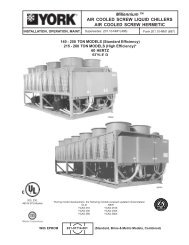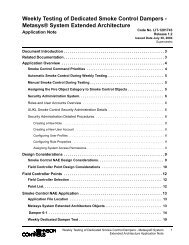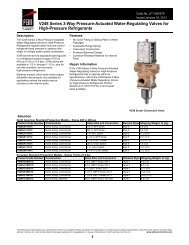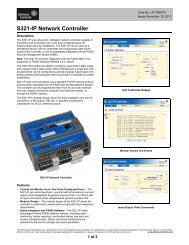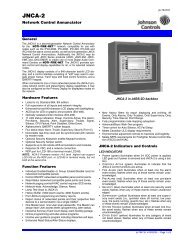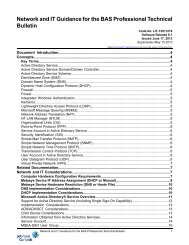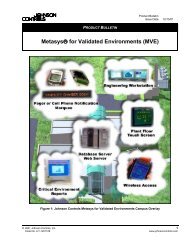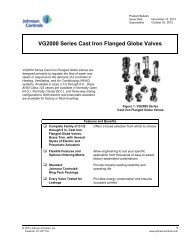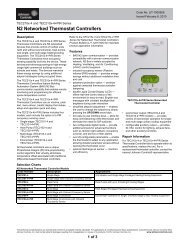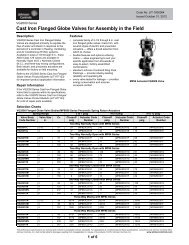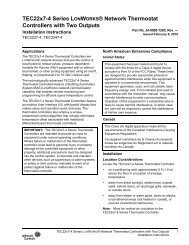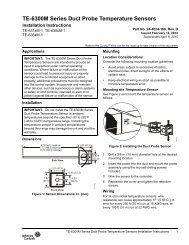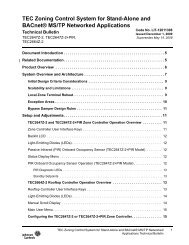YVAA Style A Air-Cooled Screw Liquid Chillers ... - Johnson Controls
YVAA Style A Air-Cooled Screw Liquid Chillers ... - Johnson Controls
YVAA Style A Air-Cooled Screw Liquid Chillers ... - Johnson Controls
Create successful ePaper yourself
Turn your PDF publications into a flip-book with our unique Google optimized e-Paper software.
FORM 201.28-NM1.1<br />
ISSUE DATE: 8/29/2012<br />
PREPARATION<br />
Commissioning of this unit should only<br />
be carried out by <strong>Johnson</strong> <strong>Controls</strong> Authorized<br />
personnel.<br />
Commissioning personnel should be thoroughly familiar<br />
with the information contained in this document before<br />
starting the unit.<br />
The following basic checks should be made with the<br />
customer power to the unit switched OFF.<br />
Inspection<br />
Proper electrical lock out and tag out<br />
procedures must be followed.<br />
Inspect unit for installation damage. If found, take action<br />
and/or repair as appropriate.<br />
Refrigerant Charge<br />
Packaged units are normally shipped as standard with a<br />
full refrigerant operating charge. Check that refrigerant<br />
pressure is present in both systems and that no leaks<br />
are apparent. If no pressure is present, a leak test must<br />
be undertaken, the leak(s) located and repaired.<br />
Do not evacuate or liquid charge with static water in<br />
the evaporator. Turn the pump on. Take care to liquid<br />
charge slowly to avoid excessive thermal stress at the<br />
charging point and to assure the refrigerant temperature<br />
in the evaporator does not go below the freezing<br />
point with liquid refrigerant in the evaporator. Once<br />
the vacuum is broken, charge into the evaporator or<br />
flash tank with the Condenser Drain Valve (Flash Tank<br />
Feed) open and the chilled liquid pump ON to the full<br />
operating charge, as detailed in SECTION 5 - TECH-<br />
NICAL DATA on Page 49.<br />
SECTION 6 - COMMISSIONING<br />
Correct System Refrigerant Charge<br />
The charge on a system should always be checked<br />
when operating for several minutes at full speed with<br />
the system stable. Stable conditions are defined as operation<br />
without fan cycling, economizer cycling, VI<br />
solenoid cycling, or any other system transient conditions.<br />
Ideal refrigerant charge will be reached when the<br />
refrigerant level in the evaporator is near the middle of<br />
the evaporator sight glass.<br />
Refrigerant should not be added or removed<br />
unless the level is at the bottom or<br />
the top of the glass. It is not necessary to<br />
weigh charge unless the entire charge has<br />
been lost. The ease of charging is possible<br />
since the microchannel coils hold only<br />
a small amount of refrigerant charge.<br />
A charging valve is located between the<br />
fixed orifice and the evaporator for adjusting<br />
charge. Charge should be added<br />
as liquid with the pump ON and liquid<br />
flowing through the evaporator.<br />
Service and Oil Line Valves<br />
Open each compressor oil, economizer, and discharge<br />
ball or service valves. If valves are of the back-seat<br />
type, open them fully (counterclockwise) then close<br />
one turn of the stem to ensure operating pressure is fed<br />
to pressure transducers.<br />
Compressor Oil<br />
To add oil to a circuit - connect a YORK hand oil pump<br />
(Part No. 470-10654-000) to the 1/4" (6.35 mm) oil<br />
charging valve on the oil separator piping with a length<br />
of clean hose or copper line, but do not tighten the flare<br />
nut. Using clean oil of the correct type (“L” oil), pump<br />
oil until all air has been purged from the hose then<br />
tighten the nut. Stroke the oil pump to add oil to the oil<br />
system. While the compressor is running at full speed,<br />
the oil level should be visible in the sight glass of the<br />
oil separator. Approximately 2 to 3.1 gallons (7.5 to<br />
11.6 liters) are present in each refrigerant system.<br />
JOHNSON CONTROLS 81<br />
6



